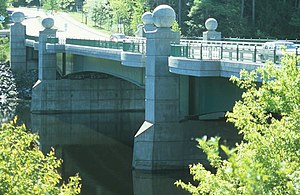| Ledyard Bridge | |
|---|---|
 | |
| Coordinates | 43°42′13″N 72°17′59″W / 43.70361°N 72.29972°W / 43.70361; -72.29972 |
| Carries | Vermont Route 10A, New Hampshire Route 10A, Appalachian Trail |
| Crosses | Connecticut River |
| Locale | Hanover, New Hampshire and Norwich, Vermont |
| Maintained by | New Hampshire Department of Transportation |
| Characteristics | |
| Design | Beam bridge, originally a covered bridge |
| History | |
| Construction start | 1998 |
| Opened | 1859, 2000 |
| Closed | 1935 |
| Location | |
The Ledyard Bridge crosses the Connecticut River to connect Hanover, New Hampshire to Norwich, Vermont. It is the third bridge at this crossing to bear the name of the adventurer John Ledyard.
History
The first "Ledyard Free Bridge" was a covered bridge built in 1859 that was the first bridge across the Connecticut not to charge a toll. (It was the latest of several bridges at this site that went back to the late 18th century.) The bridge was named after Ledyard in 1859 because its eastern abutment was near the site of a tree that Ledyard felled during 1773 in order to make the dugout canoe in which he left Dartmouth College to continue his world travels.
The bridge now standing was built between 1998 and 2000 by the New Hampshire Department of Transportation. At each end it displays a pair of "bridge balls," the controversial Classical ornaments cast in concrete that refer to the gateway to Tuck Drive nearby on the Hanover shore. They are the product of a Concord architect brought in by NHDOT to infuse some extra aesthetic appeal into the design of the bridge.
The Ledyard Bridge carries the designation of New Hampshire Route 10A and Vermont Route 10A, a short state highway linking U.S. Route 5 and Interstate 91 on the Vermont side with New Hampshire Route 10 on the New Hampshire side. The Appalachian Trail uses the pedestrian walkway to cross the river.
Border location
Although the border between New Hampshire and Vermont was set at the Vermont shore early in the states' histories, the bridge's monument to that border rests near the middle of the crossing; the reasoning is that the border was fixed before the Wilder Dam pushed the Vermont shore westward during the 1950s.
-
 Ledyard from Vermont
Ledyard from Vermont
-
 Bore shaft operations on Vermont side
Bore shaft operations on Vermont side
-
 Bore shaft operations
Bore shaft operations
-
 NH abutment footing
NH abutment footing
-
 NH view of old and new Ledyard
NH view of old and new Ledyard
-
 Ledyard from New Hampshire
Ledyard from New Hampshire
See also
References
- "BRIDGES OF THE PAST - New Hampshire Covered Bridges". www.nh.gov.
- Hard, Walter (1998) . Conuel, Thomas (series); Allen, Hervey; Carmer, Carl; Crawford, Jean (associate); Ball, Faith (art) (eds.). The Connecticut. The Rivers of America (2nd ed.). Lincoln, Massachusetts: Massachusetts Audubon Society. p. 154. ISBN 0-932691-27-7.
- Associated Press (December 31, 1994), "N.H., Vermont end dispute over design of proposed bridge", The Boston Globe (Boston, MA)
| Crossings of the Connecticut River | ||||
|---|---|---|---|---|
| ||||
- Appalachian Trail
- Bridges completed in 1859
- Bridges completed in 2000
- Buildings and structures in Norwich, Vermont
- Bridges over the Connecticut River
- Bridges in Grafton County, New Hampshire
- Road bridges in New Hampshire
- Road bridges in Vermont
- Former toll bridges in New Hampshire
- Former toll bridges in Vermont
- Beam bridges in the United States
- Interstate vehicle bridges in the United States
- 1859 establishments in New Hampshire
- 1859 establishments in Vermont